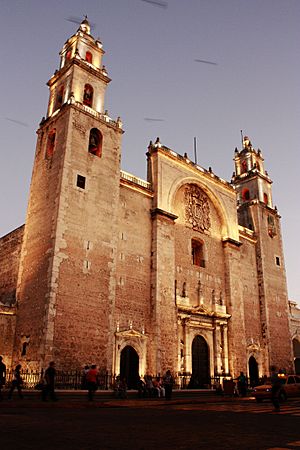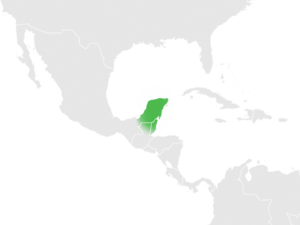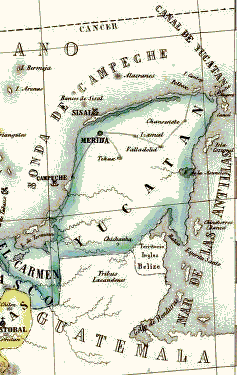Captaincy General of Yucatán facts for kids
Quick facts for kids Province of YucatanProvincia de Yucatán (Spanish) |
||||||
| Province of New Spain | ||||||
|
||||||
|
||||||
|
Map of Yucatan showing the provincial capital of Merida in the northwest.
|
||||||
| Capital city | Merida 20°58′N 89°37′W / 20.967°N 89.617°W |
|||||
| Government | Absolute monarchy with theocratic and oligarchic features | |||||
| Viceroy | ||||||
| - | 1535–1550 | Antonio de Mendoza (first) | ||||
| - | 1821 | Juan O'Donojú (last) | ||||
| Governor | ||||||
| - | 1527–1540 | Francisco de Montejo (first) | ||||
| - | 1821 | Juan María Echeverri (last) | ||||
| Legislature | Real Audiencia of Mexico | |||||
| Historical era | Spanish conquest to Spanish American wars of independence | |||||
| - | Start of Spanish conquest | September 1527 | ||||
| - | Declaration of independence | September 15, | ||||
| Today part of | ||||||
The Province of Yucatan (/ˌjʊkəˈtɑːn/ yuu-KƏ-tahn; Spanish: Provincia de Yucatán Spanish pronunciation: [pɾoˈβinsja ðe ʝukaˈtan]), or the Captaincy General, Governorate, Intendancy, or Kingdom of Yucatan, was a first-order administrative district of the Viceroyalty of New Spain in the Yucatan peninsula.
Geography
The Yucatan peninsula is a low-lying, tropical, karstic platform of circa 300,000 km2 (115,831 sq mi), bound by the Gulf of Mexico and the Caribbean Sea.
History
Sixteenth century
Prior to the Spanish conquest
The Yucatan peninsula encompassed various kuchkabalo'ob or Postclassic Mayan states. At least some of these are believed to have previously been administrative districts of Chichen Itza and Mayapan.
Peninsular residents are thought to have first learnt of the Spanish in late 1502, after Christopher Columbus's landing at Guanaja in late July or early August 1502. Spaniards are thought to have first reached the peninsula in the latter half of 1508, during a reconnaissance voyage by Juan Díaz de Solís and Vicente Yáñez Pinzón. The first Spanish residents of Yucatan were Jerónimo de Aguilar and Gonzalo Guerrero, who in 1511 had been swept towards the peninsula from their shipwreck at the Pedro Bank (southwest of Jamaica), and thereafter impressed or enslaved by a batab or mayor of the Ekab Province.
Hispano-Mayan hostilities broke out on 5 March 1517, when a Cuban expeditionary force, led by Francisco Hernández de Córdoba, was ambushed by the military or militia of the Ekab Province near that state's eponymous capital. The expeditionaries' reports of grand Mayan cities lead to further Cuban expeditions to Yucatan and the Gulf of Mexico, notably bringing about the 1519–1521 conquest of the Aztec Empire.
Spanish conquest
On 8 December 1526, Charles I of Spain granted Francisco de Montejo a capitulación de conquista or letters patent for the conquest of the Mayan states in the Yucatan peninsula. The Salamancan conquistador was thereby granted the titles and offices of adelantado, governor, captain general, and alguacil mayor of Yucatan. Montejo, with four ships and over 250 men, embarked from Seville in late June 1527, reaching Cozumel (in the Ekab Province) in late September 1527. The Spanish conquest began in 1527, upon the founding of Salamanca de Xelha (in the Ekab Province), and protracted itself to 1544, ending with the founding of Salamanca de Bacalar (in the Waymil Province).
Posterior to the Spanish conquest
Great Mayan Revolt, 1546–1547
In 1546, state and local officers, and priests, of the (recently defeated) pre-Columbian province of Kupul began organising a coalition force for a swift military strike on Merida, Valladolid, and Bacalar. Six neighbouring (former) provinces joined Kupul in the operation, which was scheduled for the full moon night of 8–9 November 1546. On said night, circa 500–600 non-allied Mayans, and fifteen to twenty encomenderos were massacred. The planned offensive on Merida faltered, while that on Valladolid devolved into a siege, broken circa two weeks afterwards by a military detachment from Merida. The strike on Bacalar likewise devolved into a blockade, broken in early 1547. The defeated coalition forces nonetheless determined on guerrilla warfare. By March 1547, most coalition troops had been defeated, exhausted by attrition, or otherwise convinced to lay down their arms. Afterwards–
- five or six of the principal instigators were tried and killed,
- circa 2,000 prisoners of war were (illegally) enslaved,
- a number of Spanish military captains were charged with and convicted of war crimes.
Seventeenth century
The Captaincy General of Yucatán was created in 1617 to provide more autonomy for the Yucatán Peninsula, previously ruled directly by a simple governor under the jurisdiction of Audiencia of Mexico. Its creation was part of the, ultimately futile, Habsburg attempt in the late 16th century to prevent incursion into the Caribbean by foreign powers, which also involved the establishment of Captaincies General in Puerto Rico, Cuba, and neighboring Guatemala. With the addition of the title of captain general to the governor of Yucatán, the province gained greater autonomy in administration and military matters. Unlike in most areas of Spanish America, no formal corregidores were used in Yucatán, and instead the governor-captain general relied on other subordinate officials to handle the oversight of local districts. The Captaincy General remained part of the Viceroyalty of New Spain, with the viceroy retaining the right to oversee the province's governance, when it was deemed necessary, and the Audiencia of Mexico taking judicial cases in appeal. The province and captaincy general covered the territory that today are the States of Campeche, Quintana Roo, Tabasco, Yucatán, and nominally the northern areas of Petén and Belize.
Law IV ("Que el Governador de Yucatan guarde las ordenes del Virrey de Nueva España") of Title I ("De los Terminos, Division, y Agregación de las Governaciones") of Book V of the Recopilación de Leyes de Indias of 1680 reproduces the November 2, 1627 royal decree (real cédula) of Philip V, which established the nature of the relationship between the Governor of Yucatán and the Viceroy of New Spain: "It is convenient that the governors and captain generals of the Province of Yucatán, precisely and in a timely manner fulfill the orders that the viceroys of New Spain give them. And we order that the governors obey them and fulfill them."
Eighteenth century
In 1786, as part of the Bourbon Reforms the Spanish Crown established an Intendancy of Yucatán covering the same area as the Province. The intendancy took control of government and military finances and had broad powers to promote the local economy.
Nineteenth century
On September 15, 1821, in the Hall of Councils of the City of Mérida, Yucatán declared its independence from Spain. Almost immediately, Governor Juan María Echeverri sent two representatives to negotiate the incorporation of Yucatán into the Mexican Empire. The incorporation into the Mexican Empire took place on November 2, 1821.
Society
Religion

The letters patent of 8 December 1526, granted to Francisco de Montejo for the conquest of the Yucatan peninsula, incorporated various provisions designed to ensure the successful conversion of Mayan residents to (Roman Catholic) Christianity. Christian proselytising efforts in the Yucatan peninsula were begun in late September 1527 by secular friars Juan Rodríguez de Caraveo, Pedro Fernández, and Carmelite friar Gregorio de San Martín, who accompanied the Montejo entrada of 1527–1528. The first known Christian baptisms in the peninsula occurred in Ekab, capital of the eponymous Postclassic Mayan province, during or shortly after an assembly of the province's batabo'ob or mayors, held at some point during December 1527 and March 1528. Franciscans began missionary work in Chak'anputun, capital of a Postclassic Mayan province of the same name, sometime during 1535 and 1537.
Education
Hispano–Christian schooling or indoctrination of Mayan children and adults was begun by Franciscan friars at the Provincial Convent of St. Francis, Merida, in 1547. Instruction included–
- Roman Catholic doctrine for all Mayan children and adults,
- (Latin) reading and writing for children of pre-eminent Mayan families,
- choral music for Mayan adults.
At least some chilamo'ob or priests (of Mayan polytheism), and members of ch'ibalo'ob or noble houses, are known to have vigorously opposed Franciscan indoctrination.
Government
Capitulaciones de conquista of 1526
The capitulaciones de conquista or letters patent for the conquest of Yucatan, granted on 8 December 1526 by Charles I of Spain to Francisco de Montejo in Granada, set out the first constitution of Spanish Yucatan.
Absolute authority was vested in the Spanish sovereign, advised and assisted by the Casa de Contratación and the Council of the Indies. Directly subordinate was the adelantado, governor, captain general, and alguacil mayor of Yucatan, who was afforded executive, legislative and judicial authority over the province. Spanish Yucatan was partitioned into municipios or municipalities, each administered by a designated cabildo or municipal-and-town council. Said municipalities were further subdivided into–
- Mayan or encomienda settlements, administered by an encomendero and a resident batab, cacique or mayor,
- Spanish or non-encomienda settlements, administered by a cabildo.
Early developments
The Real Audiencia of Mexico, established by real cédula or royal decree on 13 December 1527, was thereby set up as a superior court of judicature for Spanish Yucatan. The province was made an administrative district of the Viceroyalty of New Spain upon or shortly after the latter's formation on 17 April 1535. The New Laws of 20 November 1542 rendered null and void some parts of the adelantado's letters patent. The latter were further derogated from on 13 May 1549, upon the adelantado's suspension from the offices of governor, captain general, and alguacil mayor of Spanish Yucatan.
Economy
Capitulaciones de conquista of 1526
Francisco de Montejo's letters patent of 8 December 1526 incorporated a number of provisions designed to attract Spanish settlers to the Yucatan peninsula, including–
- assignment of conquered Mayan settlements in encomiendas,
- authorisation for a limited slave trade in Mayan prisoners,
- partial tax breaks from the quinto real, almojarifazgo, and salt tax,
- grants of two caballerías and two solares,
- authorisation to employ court fines for local public works,
- authorisation to employ the diezmo for local missionary work.
Early developments
Conquistadors had initially hoped to find significant deposits of gold and precious metals in the Yucatan peninsula. As the conquest wore on, it became increasingly apparent that none such were to be had. Consequently, agriculture was settled on as the primary economic activity of Spanish Yucatan. Some commerce, especially in dye woods, similarly developed.
Mayan cotton mantas were made legal tender in late 1542.
Legacy
See also
 In Spanish: Capitanía General de Yucatán para niños
In Spanish: Capitanía General de Yucatán para niños
- History of Belize
- History of Central America
- History of Mexico
- Republic of Yucatan – nineteenth-century sovereign state in the Yucatan peninsula
- Caste War of Yucatan – nineteenth–century Hispano–Mayan conflict in the Yucatan peninsula






